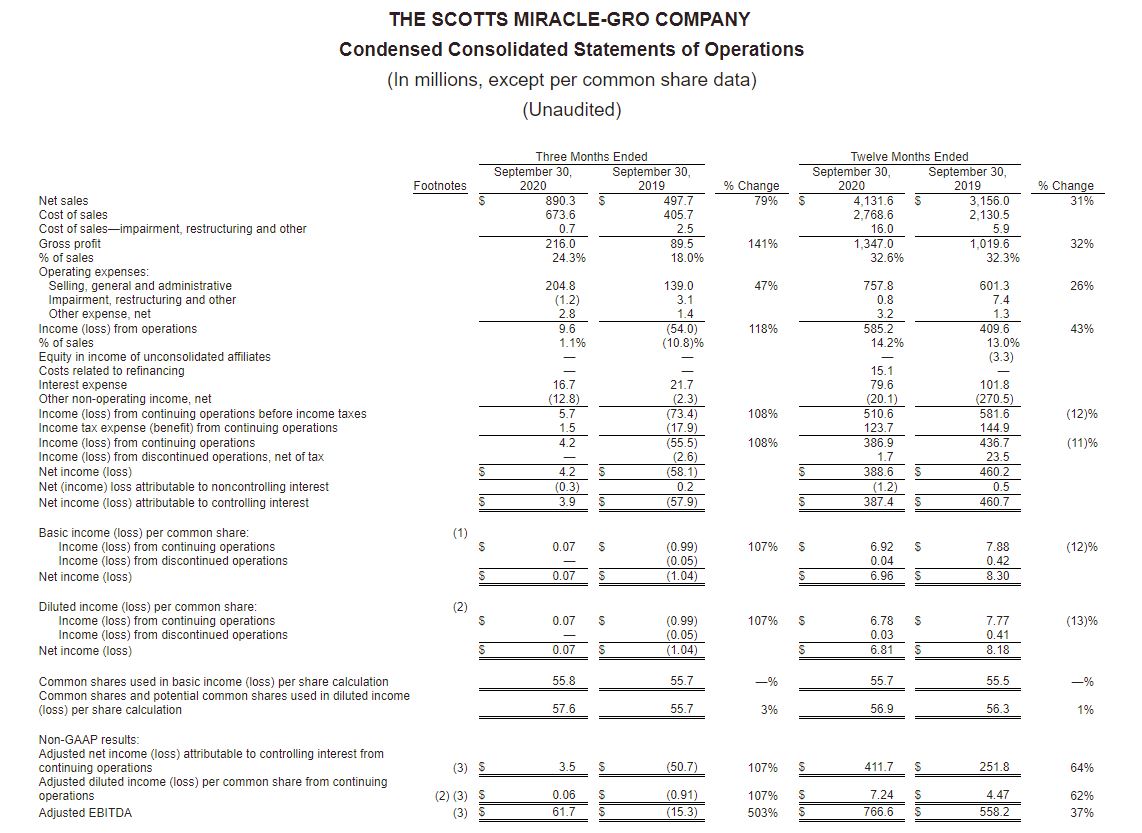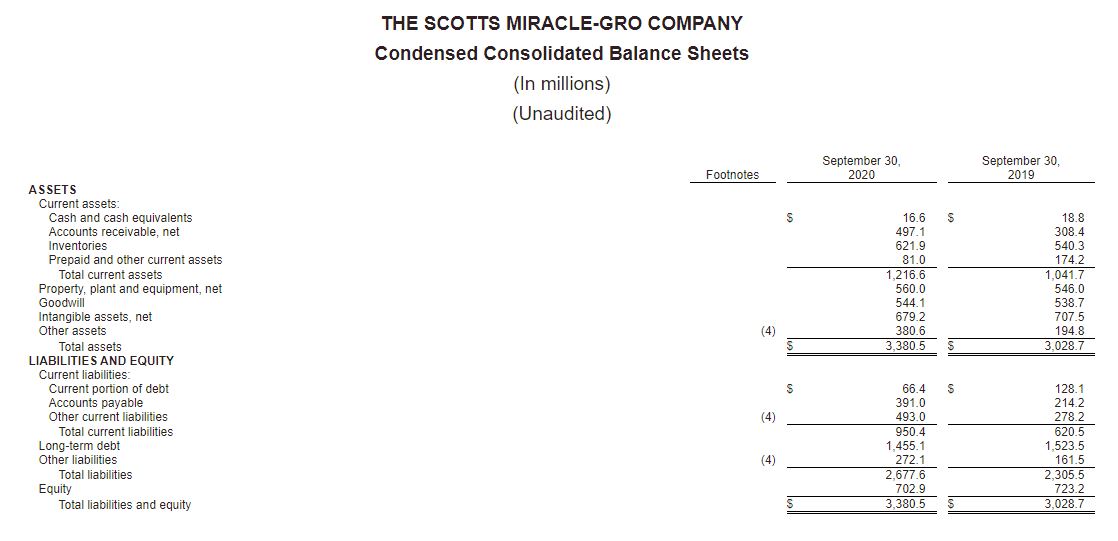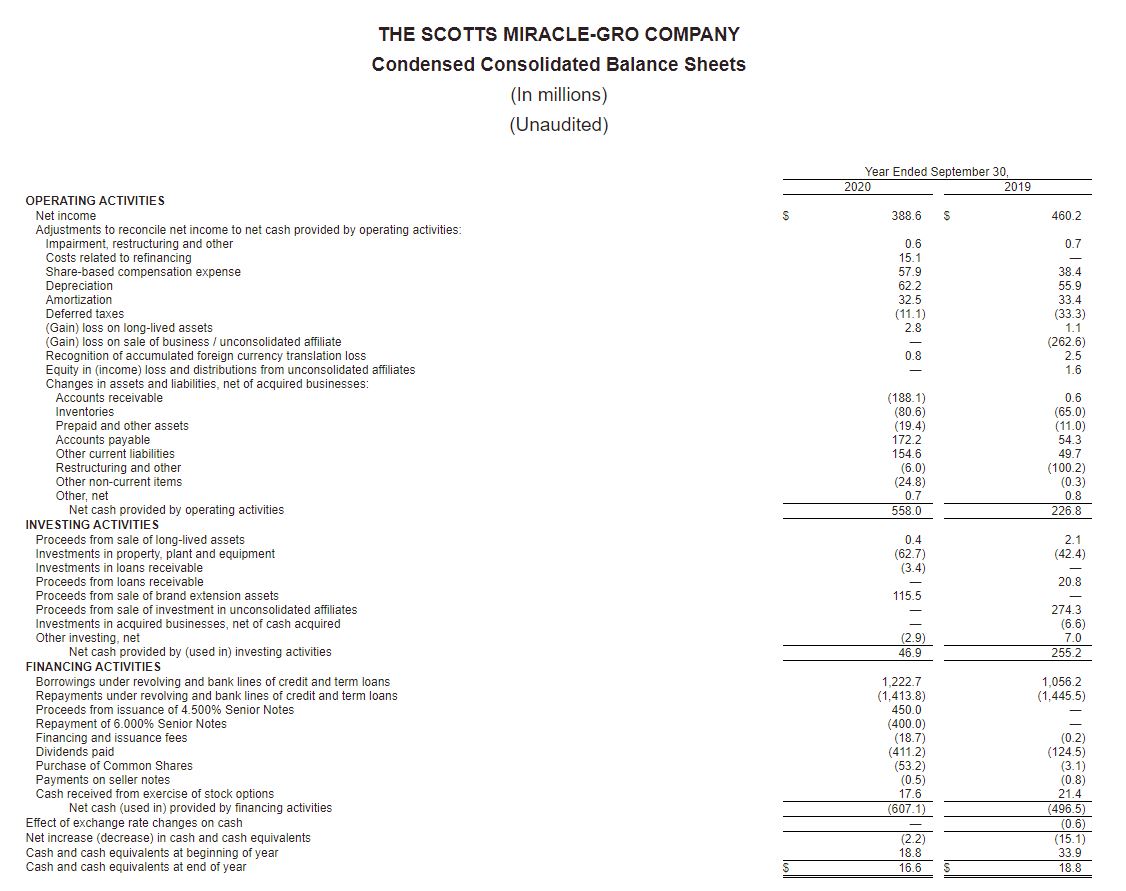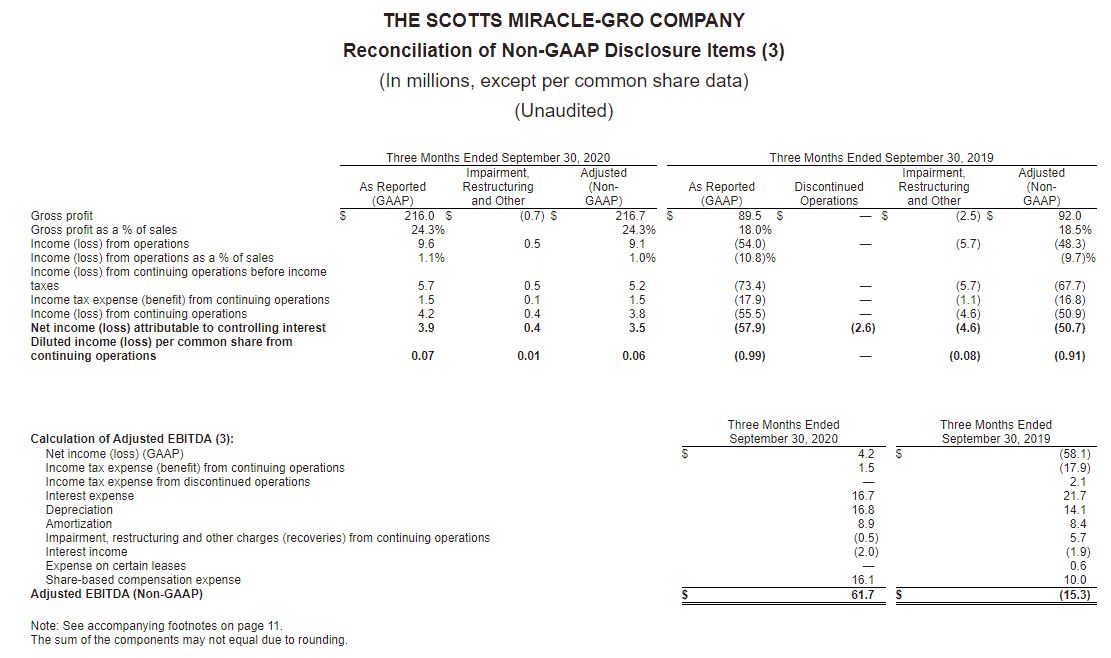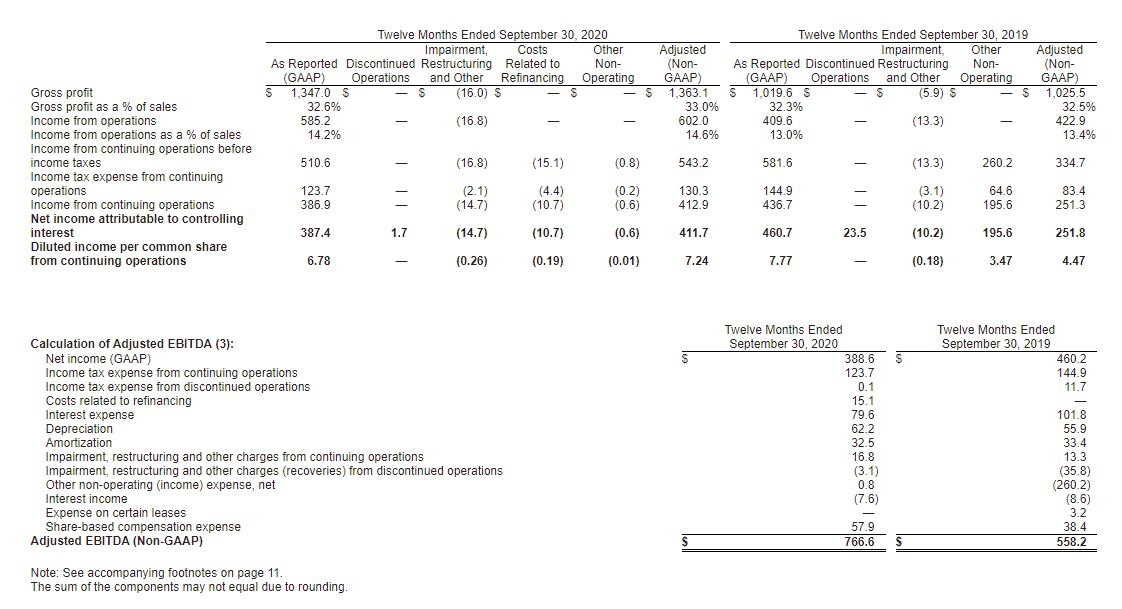
ScottsMiracle-Gro Announces Record Fourth Quarter and Full Year Results Driven by Strong Product Demand in Both Major Reporting Segments
- U.S. Consumer segment sales increase 90% in Q4; up 24% for fiscal 2020
- Hawthorne sales increase 68% in Q4; up 61% for the full year
- Full-year GAAP earnings of $6.78 per share; Q4 earnings of $0.07 per share
- Non-GAAP adjusted full-year EPS of $7.24; Q4 adjusted EPS of $0.06
- Fiscal 2021 guidance: Adjusted non-GAAP EPS $8.00 to $8.40; sales growth 0 to 5%
- Company announces letter of intent to enter 50/50 joint venture for Bonnie Plants
MARYSVILLE, Ohio, Nov. 04, 2020 (GLOBE NEWSWIRE) — The Scotts Miracle-Gro Company (NYSE: SMG), the world’s leading marketer of branded consumer lawn and garden as well as indoor and hydroponic growing products, today released record fiscal fourth quarter and full year financial results that were driven by the continued strength of both its U.S. Consumer and Hawthorne reporting segments.
The Company also established guidance for fiscal 2021 that assumes company-wide sales growth of 0 to 5 percent and expected non-GAAP adjusted earnings growth of 10 to 16 percent.
For the year ended September 30, 2020, company-wide sales increased 31 percent to a record $4.13 billion, compared with $3.16 billion a year earlier. GAAP earnings from continuing operations were $6.78 per diluted share, compared with $7.77 per share in the prior year. Non-GAAP adjusted earnings, which are the basis of the Company’s guidance and exclude impairment, restructuring, and other one-time items, were $7.24 per share compared with $4.47 per share a year ago.
The momentum we enjoyed throughout fiscal 2020 accelerated further in the fourth quarter and is carrying into the first quarter of fiscal 2021 as well.
 Jim Hagedorn, chairman and chief executive officer
Jim Hagedorn, chairman and chief executive officer
The 90 percent fourth quarter increase in our U.S. Consumer segment was driven by continued strong consumer demand and support from our retailers who were replenishing inventory levels in anticipation of continued strength. The growth in Hawthorne also continued to gain steam as September was our highest sales month ever.
“The guidance we are establishing for fiscal 2021 assumes both segments will report strong growth in the first half of the year but face difficult year-over-year comparisons from May through September. Frankly, it’s too early to accurately gauge what may happen next spring and summer and, so, we are taking a prudent approach in establishing this outlook. We currently expect to deliver adjusted earnings per share in a range of $8.00 to $8.40 in fiscal 2021, which would mark yet another year of double-digit earnings growth.”
Separately, the Company announced it has signed a non-binding letter-of-intent to acquire a 50 percent equity stake in the Bonnie Plants business. The proposed transaction would be structured as a 50/50 joint venture with Alabama Farmers Cooperative, Inc., the current owner of Bonnie Plants. The proposed deal remains subject to antitrust clearance, due diligence and negotiation of definitive agreements and is expected to close around the end of the calendar year. While the impact of the proposed transaction is expected to be accretive to earnings in fiscal 2021, it is not contemplated in the Company’s current guidance. Financial terms are not being disclosed at this time.
The proposed transaction would replace an existing relationship that gives ScottsMiracle-Gro a 25 percent financial interest in Bonnie Plants based on financing ScottsMiracle-Gro provided in 2016. As part of the proposed transaction, ScottsMiracle-Gro also would relinquish its previously negotiated option to become the majority owner of Bonnie Plants.
“There is no gardening without plants, which makes live goods the engine that drives this industry,” Hagedorn said. “We are especially enthusiastic about edible gardening, a category that has been growing for years and resonates especially well with millennial consumers. Our relationship with Bonnie Plants over the past five years has been beneficial to both parties and we look forward to working together to take the edible gardening category to new heights.”
Fourth quarter details
Company-wide sales increased 79 percent to $890.3 million. U.S. Consumer increased 90 percent to $497.2 million from $261.6 million. Hawthorne sales increased 68 percent to $351.9 million compared with $210.0 million. The increase in both segments was across all product categories, geographies and retail channels.
For the quarter, the GAAP and non-GAAP adjusted gross margin rate was 24.3 percent, compared with 18.0 percent and 18.5 percent, respectively, in the prior year. While both major reporting segments enjoyed a higher margin rate, the overall increase was driven primarily from fixed cost leverage within the U.S. Consumer segment.
SG&A was $204.8 million, a 47 percent increase from 2019, due to higher accruals for annual incentive compensation payments, one-time payments to associates not typically eligible for bonuses, as well as higher media and marketing expenses and increased charitable contributions.
“It is appropriate that our associates and our communities also benefit from the historic result we reported this year,” Hagedorn said. “We are giving $3,000 to nearly all of the 3,000 mostly hourly associates who are not in our incentive plans but who sacrificed and played an enormous role in our success this year. We also are proud to have nearly tripled our annual contribution to the ScottsMiracle-Gro Foundation, which supports the work of dozens of community and environmental groups throughout the country.”
Interest expense decreased $5 million on a year-over-year basis to $16.7 million. The Company said its leverage ratio at the end of the quarter was approximately 2.5 times average debt-to-EBITDA.
The Company reported income from continuing operations of $4.2 million, or $0.07 per diluted share, compared with a loss of $55.5 million, or $0.99 per diluted share, a year earlier. Non-GAAP adjusted income in the quarter, which excluded impairment, restructuring, as well as other one-time items, was $3.5 million, or $0.06 per diluted share, compared with a loss of $50.7 million, or $0.91 per diluted share. Historically, the Company reports a seasonal loss in the fourth quarter. Fiscal 2020 marked the first profitable fourth quarter since 2006.
Fiscal 2020 Details
Company-wide sales on a full year basis increased 31 percent to $4.13 billion compared with $3.16 billion a year ago. Sales in the U.S. Consumer segment increased 24 percent, to $2.82 billion due to strong consumer demand throughout the year. Hawthorne sales increased 61 percent to $1.08 billion due to strong demand in both new and legacy markets.
The GAAP gross margin rate on a year-to-date basis was 32.6 percent. The non-GAAP adjusted rate was 33.0 percent. These compare with 32.3 and 32.5 percent, respectively, last year. The improvement was driven by benefits in both major segments from pricing, as well as fixed cost leverage, which was partially offset by unfavorable segment mix from the significant growth in Hawthorne.
SG&A was $757.8 million, a 26 percent increase from 2019, due to higher accruals for annual and long-term incentive compensation and increased marketing and selling.
Lower borrowing and interest rates resulted in a decrease in interest expense to $79.6 million compared with $101.8 million.
GAAP income from continuing operations was $386.9 million, or $6.78 per diluted share, compared to $436.7 million, or $7.77 per share in the prior year. Non-GAAP adjusted earnings, which excluded impairment, restructuring, as well as the other one-time items, were $411.7 million, or $7.24 per share, compared with $251.8 million, or $4.47 per share a year ago.
Operating cash flow for the full year was $558.0 million, compared with $226.8 million. Free cash flow, which the Company defines as operating cash flow minus capital expenditures, was $495.3 million.
Fiscal 2021 outlook
The Company established guidance for fiscal 2021 based on an expectation of continued earnings growth in both major segments. Management said it expects sales growth on a company-wide basis of 0 to 5 percent. It expects Hawthorne sales to grow approximately 15 to 20 percent and U.S. Consumer sales to be flat to down 5 percent.
Non-GAAP adjusted earnings per share are anticipated to be in a range of $8.00 to $8.40 with the gross margin rate declining approximately 50 basis points, a 6 to 11 percent decline in SG&A, and interest expense declining approximately $10 million. Free cash flow is expected to be approximately $325 million.
“We are extremely well-positioned to deliver another year of strong earnings improvement,” said Randy Coleman, executive vice president and chief financial officer. “We expect first half results for both major segments to trend well above our full-year outlook and to be partly offset by challenging comparisons in the second half of the year. We remain committed, just as we were in 2020, to providing timely updates to investors with as much transparency as possible throughout the year.”
Management will outline its 2021 expectations in more detail during its scheduled conference call with the investment community at 9 a.m. Eastern time today.
Conference Call and Webcast Scheduled for 9 a.m. ET Today, November 4
The Company will discuss results during a webcast and conference call today at 9:00 a.m. Eastern Time. Conference call participants should call 1-800-263-0877 (Conference Code: 4510222) A live webcast of the call will be available on the investor relations section of the Company’s website at http://investor.scotts.com. An archive of the webcast will remain available for at least 12 months. In addition, a replay of the call can be heard by calling 1-888-203-1112. The replay will be available for 30 days.
About ScottsMiracle-Gro
With approximately $4.1 billion in sales, the Company is one of the world’s largest marketers of branded consumer products for lawn and garden care. The Company’s brands are among the most recognized in the industry. The Company’s Scotts®, Miracle-Gro® and Ortho® brands are market-leading in their categories. The Company’s wholly-owned subsidiary, The Hawthorne Gardening Company, is a leading provider of nutrients, lighting and other materials used in the indoor and hydroponic growing segment. For additional information, visit us at www.scottsmiraclegro.com
THE SCOTTS MIRACLE-GRO COMPANY
Segment Results
(In millions)
(Unaudited)
The Company divides its business into three reportable segments: U.S. Consumer, Hawthorne and Other. U.S. Consumer consists of the Company’s consumer lawn and garden business located in the geographic United States. Hawthorne consists of the Company’s indoor, urban and hydroponic gardening business. Other consists of the Company’s consumer lawn and garden business in geographies other than the U.S. and the Company’s product sales to commercial nurseries, greenhouses and other professional customers. In addition, Corporate consists of general and administrative expenses and certain other income/expense items not allocated to the business segments. This identification of reportable segments is consistent with how the segments report to and are managed by the chief operating decision maker of the Company.
The performance of each reportable segment is evaluated based on several factors, including income (loss) from continuing operations before income taxes, amortization, impairment, restructuring and other charges (“Segment Profit (Loss)”), which is a non-GAAP financial measure. Senior management uses Segment Profit (Loss) to evaluate segment performance because they believe this measure is indicative of performance trends and the overall earnings potential of each segment.
The following tables present financial information for the Company’s reportable segments for the periods indicated:
THE SCOTTS MIRACLE-GRO COMPANY
Footnotes to Preceding Financial Statements
(1) Basic income (loss) per common share amounts are calculated by dividing income (loss) attributable to controlling interest from continuing operations, income (loss) from discontinued operations and net income (loss) attributable to controlling interest by the weighted average number of common shares outstanding during the period.
(2) Diluted income (loss) per common share amounts are calculated by dividing income (loss) attributable to controlling interest from continuing operations, income (loss) from discontinued operations and net income (loss) attributable to controlling interest by the weighted average number of common shares, plus all potential dilutive securities (common stock options, performance shares, performance units, restricted stock and restricted stock units) outstanding during the period.
(3) Reconciliation of Non-GAAP Measures
Use of Non-GAAP Measures
To supplement the financial measures prepared in accordance with U.S. generally accepted accounting principles (“GAAP”), the Company uses non-GAAP financial measures. The reconciliations of these non-GAAP financial measures to the most directly comparable financial measures calculated and presented in accordance with GAAP are shown in the tables above. These non-GAAP financial measures should not be considered in isolation from, or as a substitute for or superior to, financial measures reported in accordance with GAAP. Moreover, these non-GAAP financial measures have limitations in that they do not reflect all the items associated with the operations of the business as determined in accordance with GAAP. Other companies may calculate similarly titled non-GAAP financial measures differently than the Company, limiting the usefulness of those measures for comparative purposes.
In addition to GAAP measures, management uses these non-GAAP financial measures to evaluate the Company’s performance, engage in financial and operational planning and determine incentive compensation because it believes that these measures provide additional perspective on and, in some circumstances are more closely correlated to, the performance of the Company’s underlying, ongoing business.
Management believes that these non-GAAP financial measures are useful to investors in their assessment of operating performance and the valuation of the Company. In addition, these non-GAAP financial measures address questions routinely received from analysts and investors and, in order to ensure that all investors have access to the same data, management has determined that it is appropriate to make this data available to all investors. Non-GAAP financial measures exclude the impact of certain items (as further described below) and provide supplemental information regarding operating performance. By disclosing these non-GAAP financial measures, management intends to provide investors with a supplemental comparison of operating results and trends for the periods presented. Management believes these measures are also useful to investors as such measures allow investors to evaluate performance using the same metrics that management uses to evaluate past performance and prospects for future performance. Management views free cash flow as an important measure because it is one factor used in determining the amount of cash available for dividends and discretionary investment. Management views free cash flow productivity as a useful measure to help investors understand the Company’s ability to generate cash.
Exclusions from Non-GAAP Financial Measures
Non-GAAP financial measures reflect adjustments based on the following items:
- Impairments, which are excluded because they do not occur in or reflect the ordinary course of the Company’s ongoing business operations and their exclusion results in a metric that provides supplemental information about the sustainability of operating performance.
- Restructuring and employee severance costs, which include charges for discrete projects or transactions that fundamentally change the Company’s operations and are excluded because they are not part of the ongoing operations of its underlying business, which includes normal levels of reinvestment in the business.
- Costs related to refinancing, which are excluded because they do not typically occur in the normal course of business and may obscure analysis of trends and financial performance. Additionally, the amount and frequency of these types of charges is not consistent and is significantly impacted by the timing and size of debt financing transactions.
- Discontinued operations and other unusual items, which include costs or gains related to discrete projects or transactions and are excluded because they are not comparable from one period to the next and are not part of the ongoing operations of the Company’s underlying business.
The tax effect for each of the items listed above is determined using the tax rate and other tax attributes applicable to the item and the jurisdiction(s) in which the item is recorded.
Definitions of Non-GAAP Financial Measures
The reconciliations of non-GAAP disclosure items include the following financial measures that are not calculated in accordance with GAAP and are utilized by management in evaluating the performance of the business, engaging in financial and operational planning, the determination of incentive compensation, and by investors and analysts in evaluating performance of the business:
Adjusted gross profit: Gross profit excluding impairment, restructuring and other charges / recoveries.
Adjusted income (loss) from operations: Income (loss) from operations excluding impairment, restructuring and other charges / recoveries.
Adjusted income (loss) from continuing operations before income taxes: Income (loss) from continuing operations before income taxes excluding impairment, restructuring and other charges / recoveries and costs related to refinancing.
Adjusted income tax expense (benefit) from continuing operations: Income tax expense (benefit) from continuing operations excluding the tax effect of impairment, restructuring and other charges / recoveries and costs related to refinancing.
Adjusted income (loss) from continuing operations: Income (loss) from continuing operations excluding impairment, restructuring and other charges / recoveries and costs related to refinancing, each net of tax.
Adjusted net income (loss) attributable to controlling interest from continuing operations: Net income (loss) attributable to controlling interest excluding impairment, restructuring and other charges / recoveries, costs related to refinancing and discontinued operations, each net of tax.
Adjusted diluted income (loss) per common share from continuing operations: Diluted net income (loss) per common share from continuing operations excluding impairment, restructuring and other charges / recoveries and costs related to refinancing, each net of tax.
Adjusted EBITDA: Net income (loss) before interest, taxes, depreciation and amortization as well as certain other items such as the impact of the cumulative effect of changes in accounting, costs associated with debt refinancing and other non-recurring or non-cash items affecting net income (loss). The presentation of adjusted EBITDA is intended to be consistent with the calculation of that measure as required by the Company’s borrowing arrangements, and used to calculate a leverage ratio (maximum of 4.75 at September 30, 2020) and an interest coverage ratio (minimum of 3.00 for the twelve months ended September 30, 2020).
Free cash flow: Net cash provided by (used in) operating activities reduced by investments in property, plant and equipment.
Free cash flow productivity: Ratio of free cash flow to net income (loss).
For the three and twelve months ended September 30, 2020, the following items were adjusted, in accordance with the definitions above, to arrive at the non-GAAP financial measures:
- The World Health Organization recognized a novel strain of coronavirus (“COVID-19”) as a public health emergency of international concern on January 30, 2020 and as a global pandemic on March 11, 2020. In response to the COVID-19 pandemic, the Company has implemented additional measures intended to both protect the health and safety of its employees and maintain its ability to provide products to its customers, including (i) requiring a significant part of its workforce to work from home, (ii) monitoring its employees for COVID-19 symptoms, (iii) making additional personal protective equipment available to its operations team, (iv) requiring all manufacturing and warehousing associates to take their temperatures before beginning a shift, (v) modifying work methods and schedules of its manufacturing and field associates to create distance or add barriers between associates, consumers and others, (vi) expanding cleaning efforts at its operation centers, (vii) modifying attendance policies so that associates may elect to stay home if they have symptoms, (viii) prioritizing production for goods that are more essential to its customers and (ix) implementing an interim premium pay allowance for associates in its field sales force as well as those still working in manufacturing or distribution centers. In addition, to help address the critical shortage of personal protective equipment in the fight against COVID-19, the Company shifted production in its Temecula, California manufacturing plant to produce face shields to help protect healthcare workers and first responders in critical need areas across the country. Costs incurred during the three months ended September 30, 2020 were not material. During the twelve months ended September 30, 2020, the Company incurred costs of $15.5 million in the “Cost of sales—impairment, restructuring and other” line in the Condensed Consolidated Statements of Operations and incurred costs of $3.9 million in the “Impairment, restructuring and other” line in the Condensed Consolidated Statements of Operations associated with the COVID-19 pandemic primarily related to premium pay. These direct and incremental costs were excluded from the Company’s non-GAAP financial measures because they are not comparable from one period to the next and are not expected to be part of the ongoing operations of the Company’s underlying business.
- In connection with the acquisition of Sunlight Supply during the third quarter of fiscal 2018, the Company announced the launch of an initiative called Project Catalyst, which is a company-wide restructuring effort to reduce operating costs throughout the U.S. Consumer, Hawthorne and Other segments and drive synergies from recent acquisitions within the Hawthorne segment. Costs incurred during the three and twelve months ended September 30, 2020 related to Project Catalyst were not material. Additionally, during the three and twelve months ended September 30, 2020, the Company received zero and $2.6 million, respectively, from the final settlement of escrow funds related to a previous Hawthorne acquisition that was recognized in the “Impairment, restructuring and other” line in the Condensed Consolidated Statements of Operations.
- On October 23, 2019, the Company redeemed all of its outstanding 6.000% Senior Notes for a redemption price of $412.5 million, comprised of $0.5 million of accrued and unpaid interest, $12.0 million of redemption premium, and $400.0 million for outstanding principal amount. The $12.0 million redemption premium was recognized in the “Costs related to refinancing” line on the Condensed Consolidated Statements of Operations during the first quarter of fiscal 2020. Additionally, the Company had $3.1 million in unamortized bond issuance costs associated with the 6.000% Senior Notes, which were written-off during the first quarter of fiscal 2020 and were recognized in the “Costs related to refinancing” line in the Condensed Consolidated Statements of Operations.
- The Company recognized insurance recoveries of zero and $1.5 million related to the previously disclosed legal matter In re Morning Song Bird Food Litigation during the three and twelve months ended September 30, 2020, respectively, in the “Income (loss) from discontinued operations, net of tax” line in the Condensed Consolidated Statements of Operations.
For the three and twelve months ended September 30, 2019, the following items were adjusted, in accordance with the definitions above, to arrive at the non-GAAP financial measures:
- On April 1, 2019, the Company sold all of its noncontrolling equity interest in a joint venture with products supporting the professional U.S. industrial, turf and ornamental market for cash proceeds of $36.6 million. During the three and twelve months ended September 30, 2019, the Company recognized a pre-tax gain of zero and $2.9 million, respectively, related to this sale in the “Other non-operating income, net” line in the Condensed Consolidated Statements of Operations.
- On March 19, 2019, the Company entered into an agreement under which it sold, to TruGreen Companies L.L.C., a subsidiary of TruGreen Holding Corporation, all of its approximately 30% equity interest in Outdoor Home Services Holdings LLC, a lawn services joint venture between the Company and TruGreen Holding Corporation (the “TruGreen Joint Venture”). Under the terms of the agreement, the Company received cash proceeds of $234.2 million related to the sale of its equity interest in the TruGreen Joint Venture and $18.4 million related to the payoff of second lien term loan financing by the TruGreen Joint Venture. During the three and twelve months ended September 30, 2019, the Company recognized a pre-tax gain of zero and $259.8 million, respectively, related to this sale in the “Other non-operating income, net” line in the Condensed Consolidated Statement of Operations.
- During the three and twelve months ended September 30, 2019, the Company recognized charges of $5.7 million and $13.7 million, respectively, related to Project Catalyst. During the three and twelve months ended September 30, 2019, the Company recognized charges of $2.5 million and $5.9 million, respectively, in the “Cost of sales—impairment, restructuring and other” line in the Condensed Consolidated Statements of Operations related to employee termination benefits, facility closure costs and impairment of property, plant and equipment. During the three and twelve months ended September 30, 2019, the Company recognized charges of $3.2 million and $7.8 million, respectively, in the “Impairment, restructuring and other” line in the Condensed Consolidated Statements of Operations related to employee termination benefits and facility closure costs. The Company also recognized a charge of zero and $2.5 million for the three and twelve months ended September 30, 2019, respectively, in the “Other non-operating income, net” line in the Condensed Consolidated Statements of Operations related to the write-off of accumulated foreign currency translation loss adjustments of a foreign subsidiary that was substantially liquidated.
- The Company recognized a favorable adjustment of zero and $0.4 million related to the previously disclosed legal matter In re Scotts EZ Seed Litigation during the three and twelve months ended September 30, 2019, respectively, in the “Impairment, restructuring and other” line in the Condensed Consolidated Statements of Operations.
- The Company recognized a favorable adjustment of zero and $22.5 million related to the previously disclosed legal matter In re Morning Song Bird Food Litigation during the three and twelve months ended September 30, 2019, respectively, in the “Income (loss) from discontinued operations, net of tax” line in the Condensed Consolidated Statements of Operations as a result of the final resolution of the previously disclosed settlement agreement. In addition, during the three and twelve months ended September 30, 2019, the Company recognized insurance recoveries of zero and $13.4 million, respectively, related to this matter in the “Income (loss) from discontinued operations, net of tax” line in the Condensed Consolidated Statements of Operations.
Forward Looking Non-GAAP Measures
In this earnings release, the Company presents its outlook for fiscal 2021 non-GAAP adjusted EPS. The Company does not provide a GAAP EPS outlook, which is the most directly comparable GAAP measure to non-GAAP adjusted EPS, because changes in the items that the Company excludes from GAAP EPS to calculate non-GAAP adjusted EPS, described above, can be dependent on future events that are less capable of being controlled or reliably predicted by management and are not part of the Company’s routine operating activities. Additionally, due to their unpredictability, management does not forecast the excluded items for internal use and therefore cannot create or rely on a GAAP EPS outlook without unreasonable efforts. The timing and amount of any of the excluded items could significantly impact the Company’s GAAP EPS. As a result, the Company does not provide a reconciliation of guidance for non-GAAP adjusted EPS to GAAP EPS, in reliance on the unreasonable efforts exception provided under Item 10(e)(1)(i)(B) of Regulation S-K.
(4) Effective October 1, 2019, the Company adopted Accounting Standards Codification (“ASC”) 842, Leases (“ASC 842”). This guidance requires lessees to recognize a lease liability for the obligation to make lease payments and a right-of-use asset for the right to use the underlying asset for the lease term. The Company elected the optional transition method and adopted the new guidance on October 1, 2019 on a modified retrospective basis with no restatement of prior period amounts. Fiscal 2019 balances and related disclosures supporting those comparative period balances continue to be presented under ASC 840, Leases. As allowed under the new accounting standard, the Company elected to apply practical expedients to carry forward the original lease determinations, lease classifications and accounting of initial direct costs for all asset classes at the time of adoption. The Company also elected to exclude short-term leases from its Condensed Consolidated Balance Sheets. The Company’s adoption of the new standard resulted in the recognition of right-of-use assets of $129.6 million in the “Other assets” line in the Condensed Consolidated Balance Sheet, liabilities of $45.4 million in the “Other current liabilities” line in the Condensed Consolidated Balance Sheet and liabilities of $88.8 million in the “Other liabilities” line in the Condensed Consolidated Balance Sheet as of the October 1, 2019 adoption date. Adoption of the new standard did not result in a material cumulative effect adjustment to equity as of the date of adoption and did not have a material impact on the Company’s Condensed Consolidated Statements of Operations or Cash Flows.
(5) For the twelve months ended September 30, 2019, net cash provided by operating activities and free cash flow include cash tax payments associated with the disposition of the TruGreen Joint Venture of approximately $100.0 million and payments made in connection with previously disclosed litigation settlements related to legal matters In re Scotts Litigation and In re Morning Song Bird Food Litigation, net of insurance reimbursements and taxes, of approximately $45.0 million.

